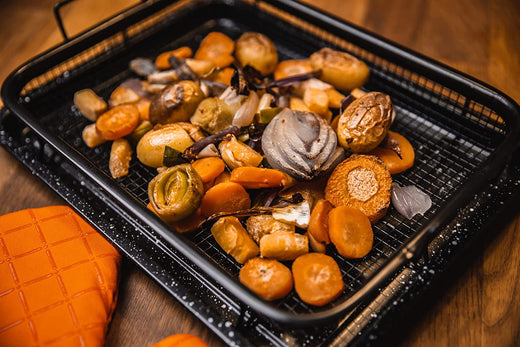Eating Whole Foods: A Path to Health and Vitality
In today’s fast-paced world, where convenience often takes precedence over nutrition, the concept of eating whole foods has gained significant traction. Whole foods—unprocessed or minimally processed foods in their natural state—offer a host of benefits for both physical and mental health. This blog post explores what constitutes whole foods, the numerous advantages of incorporating them into your diet, and tips for cooking with whole foods to maximise their nutritional potential.
What Are Whole Foods?
Whole foods are foods that are as close to their natural form as possible. They are free from additives, artificial ingredients, and extensive processing. Examples of whole foods include:
-
Fresh fruits and vegetables
-
Whole grains (such as quinoa, brown rice, and oats)
-
Legumes (like lentils, chickpeas, and beans)
-
Nuts and seeds
-
Fresh meats, fish, and poultry
-
Unprocessed dairy products
These foods are rich in essential nutrients such as vitamins, minerals, fibre, and antioxidants, making them a cornerstone of a healthy diet.
The Benefits of Eating Whole Foods
-
Rich in Nutrients Whole foods are naturally packed with essential nutrients. Unlike processed foods that often lose their nutritional value during manufacturing, whole foods retain their vitamins, minerals, and fibre. For instance, whole grains contain the bran and germ, which are rich in B vitamins, iron, and magnesium. Similarly, fresh fruits and vegetables are brimming with antioxidants that help combat oxidative stress.
-
Improved Digestion The high fibre content in whole foods supports digestive health. Fibre helps regulate bowel movements, prevents constipation, and feeds beneficial gut bacteria. A diet rich in fibre can also reduce the risk of developing conditions such as irritable bowel syndrome (IBS) and diverticulitis.
-
Weight Management Whole foods are naturally low in calories and high in volume, making them ideal for weight management. They keep you full for longer, reducing the likelihood of overeating. For example, eating a bowl of fresh salad is far more satiating than consuming a bag of crisps, despite the latter often containing more calories.
-
Reduced Risk of Chronic Diseases A diet centred around whole foods has been shown to reduce the risk of chronic diseases such as heart disease, type 2 diabetes, and certain types of cancer. Whole grains, for example, are associated with a lower risk of cardiovascular diseases due to their ability to improve cholesterol levels and regulate blood sugar.
-
Enhanced Mental Wellbeing What you eat doesn’t just impact your body; it also affects your brain. Whole foods provide the nutrients necessary for brain health, including omega-3 fatty acids found in fish and flaxseeds, and antioxidants found in berries. These nutrients can improve mood, cognitive function, and even reduce the risk of depression.
-
Sustainability and Environmental Benefits Choosing whole foods can also have a positive impact on the environment. Whole foods often require less energy to produce and package, reducing their carbon footprint. Buying locally grown, seasonal whole foods further minimises environmental impact by cutting down on transportation emissions.
Transitioning to a Whole Foods Diet
Shifting to a diet based on whole foods doesn’t have to be overwhelming. Here are some practical steps to get started:
-
Start Small Begin by incorporating more fruits and vegetables into your meals. Swap processed snacks like biscuits and crisps for whole food alternatives such as nuts, seeds, or fresh fruit.
-
Read Labels When buying packaged foods, scrutinise the labels. Opt for items with short ingredient lists featuring recognisable, natural components.
-
Cook at Home Preparing your meals at home allows you to control the ingredients and avoid hidden additives. Start with simple recipes and gradually experiment with more complex dishes.
-
Shop Smart Frequent farmer’s markets and the fresh produce section of supermarkets. Prioritise organic and locally grown options when possible.
-
Plan Your Meals Planning your meals for the week can help ensure you have a variety of whole foods on hand and reduce the temptation to rely on processed options.
Cooking with Whole Foods
Cooking with whole foods is not only healthy but also an opportunity to explore a world of flavours and textures. Here are some tips to make the most of your whole food ingredients:
-
Embrace Simplicity Whole foods often shine with minimal preparation. A fresh tomato salad with olive oil, basil, and a sprinkle of sea salt can be just as satisfying as a complicated dish.
-
Experiment with Spices and Herbs Herbs and spices can elevate the flavour of whole foods without the need for artificial seasonings. Try turmeric, cumin, or paprika for warming spices, or fresh herbs like parsley and coriander for a burst of freshness.
-
Utilise Batch Cooking Prepare large quantities of whole grains, legumes, and roasted vegetables at the beginning of the week. This can save time and make it easier to assemble balanced meals on busy days.
-
Explore Global Cuisines Many traditional cuisines are built around whole foods. Mediterranean dishes often feature fresh vegetables, whole grains, and olive oil, while Asian cuisine incorporates rice, tofu, and a variety of fresh greens.
-
Invest in Quality Cookware Using high-quality cookware, such as cast iron skillets and non-stick pans to make cooking with whole foods more enjoyable and efficient.
-
Get Creative with Snacks Instead of reaching for processed snacks, make your own. Roast chickpeas with your favourite spices for a crunchy treat, or blend nuts and dates into energy balls for a naturally sweet pick-me-up.
Addressing Common Challenges
Switching to a whole foods diet isn’t without its challenges. Here’s how to overcome some common hurdles:
-
Time Constraints Cooking from scratch can be time-consuming, but meal prepping and batch cooking can help. Investing in a slow cooker or pressure cooker can also simplify the process.
-
Cost Concerns While some whole foods like organic produce can be pricey, others, such as lentils, beans, and seasonal fruits, are budget-friendly. Buying in bulk and freezing excess can also reduce costs.
-
Picky Eaters If you have children or family members who are resistant to change, try introducing whole foods gradually. Add grated vegetables to pasta sauces, or blend fruits into smoothies to make them more appealing.
-
Cravings for Processed Foods Cravings are natural when transitioning to a healthier diet. Address them by finding satisfying whole food alternatives. For example, if you crave sweets, opt for a piece of dark chocolate or a handful of dried fruit.
Embracing a diet rich in whole foods is a transformative step towards better health and wellbeing. By prioritising fresh, natural ingredients, you can fuel your body with the nutrients it needs, reduce the risk of chronic diseases, and even contribute to a healthier planet. While the transition may require effort and adjustment, the benefits are undeniably worth it. Cooking with whole foods can be a joyful and creative process, opening the door to a lifetime of delicious, nutritious meals.
Start small, experiment with flavours, and savour the journey towards a healthier, happier you. After all, food is more than just fuel; it’s a cornerstone of our physical, emotional, and social lives. By choosing whole foods, you’re not just making a choice for yourself but also for a more sustainable and nourishing world.

